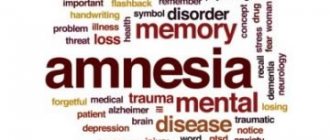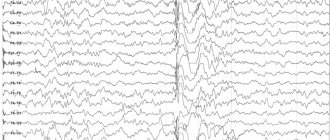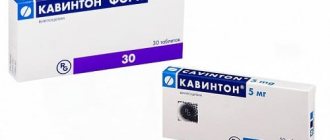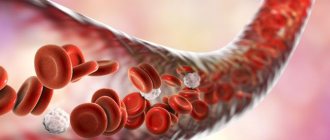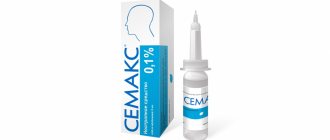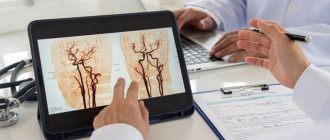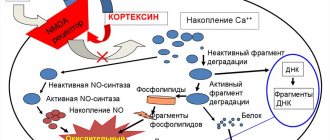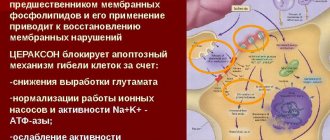Composition and release form
| Capsules | 1 caps. |
| choline alfoscerate | 400 mg |
| excipients: purified water; glycerol | |
| capsule shell composition: gelatin; esitol; sorbitans; sodium ethyl parahydroxybenzoate; sodium propyl parahydroxybenzoate; titanium dioxide (E171); iron (III) metahydroxide (E172) |
in a blister pack 14 pcs.; in a cardboard pack 1 package.
| Solution for intravenous and intramuscular administration | 4 ml |
| choline alfoscerate | 1000 mg |
| inactive ingredient: water for injection |
in ampoules of 4 ml; in a blister pack there are 1 or 3 ampoules, in a cardboard pack there is 1 ampoules.
Compound
The basis of the composition is the chemical compound choline alphoscerate.
The area of action of the component extends to choline receptors in the central nervous system.
To ensure that the product is better absorbed by the body, the active ingredient is supplemented with:
- esithol;
- sodium ethyl parahydroxybenzoate;
- gelatin;
- sodium propyl parahydroxybenzoate;
- sorbitans;
- metahydroxide;
- titanium dioxide, iron.
To produce a liquid form, the active ingredient is supplemented with glycerin and liquid in the form of purified water.
Pharmacodynamics
Improves the transmission of nerve impulses in cholinergic neurons; has a positive effect on the plasticity of neuronal membranes and receptor function. Improves cerebral blood flow, enhances metabolic processes in the brain, activates the structures of the reticular formation of the brain and restores consciousness in case of traumatic brain injury.
It has a preventive and corrective effect on such pathogenetic factors of involutional psychoorganic syndrome as changes in the phospholipid composition of neuronal membranes and a decrease in cholinergic activity.
Experimental studies have shown that Gliatilin stimulates the dose-dependent release of acetylcholine under physiological conditions of neurotransmission.
When ingested, it is broken down by enzymes into choline and glycerophosphate.
Gliatilin, on the one hand, being a choline donor, increases the synthesis of acetylcholine and has a positive effect on neurotransmission, on the other hand, glycerophosphate is involved in the synthesis of phosphatidylcholine (membrane phospholipid), as a result, both have a positive effect on membrane elasticity and receptor function, which improves synaptic transmission.
Thus, pharmacodynamic studies have shown that Gliatilin acts on the synaptic, incl. cholinergic neurotransmission; plasticity of the neuronal membrane; receptor function.
Pharmacology
The therapeutic effect with high effectiveness is ensured due to the physical and chemical properties of the constituent chemical compounds.
Among the main ones:
- influence on systemic blood flow by accelerating blood circulation;
- activation of metabolic functions;
- stimulation of the reticular formation;
- restoration of lost functionality in case of various types of injuries (damage to brain tissue).
The nootropic corrects the factors of involutional psychoorganic syndrome.
This process is based on the suppression of cholinergic activity, as a result of which the amount of phospholipids in neuronal membranes changes.
Choline alfoscerate easily passes through the morphological structures of the brain, increasing the concentration of the active component mainly in the tissues of the brain, liver and lungs. Under the influence of metabolic processes, the substance is converted into carbon dioxide, after which it is excreted from the body through the intestines and kidneys.
Indications
acute period of TBI with a predominantly brain stem level of damage (impaired consciousness, coma, focal hemispheric symptoms, symptoms of brain stem damage);
ischemic (acute and recovery period) and hemorrhagic stroke (recovery period);
degenerative and involutional psychoorganic syndromes and consequences of cerebrovascular insufficiency, such as primary and secondary disorders of mnestic functions, characterized by memory impairment, confusion, disorientation, decreased motivation, initiative, and ability to concentrate;
changes in the emotional and behavioral sphere: emotional lability, increased irritability, decreased interest, senile pseudomelancholy;
multi-infarct dementia.
Indications for use
In medicine, nootropic medicine is used for the following pathologies:
- disturbances of visual memory, speech functions;
- syndromes characterized by a decrease in intelligence, memory and other degenerative damage (when the cause of their development is cerebrovascular insufficiency);
- decreased cognitive activity, dementia.
The drug is highly effective in correcting psycho-emotional states, behavioral disorders, and other central nervous system pathologies.
Gliatilin is included in complex therapy to eliminate the consequences that arise from traumatic brain injuries (in the acute phase), when the patient experiences loss of consciousness, a coma, and focal hemispheric symptoms.
Other uses of the medicine:
- for strokes to relieve acute symptoms;
- for rehabilitation after a stroke (promotes the restoration of physical skills and consciousness).
The neuroprotector is also used in therapy for children.
It is considered justified to use the medicine for the following problems:
- neuroses, nervous tics;
- autism;
- ADHD;
- hydrocephalic syndrome;
- cerebral palsy;
- with mental retardation, mental retardation;
- with birth injuries of the brain;
- during labor hypoxia.
Directions for use and doses
Injections: IM or IV (drops).
Capsules: orally, before meals.
Adults, in acute conditions: IM - at a dose of 1000 mg/day (1 amp.) or IV - 1000-3000 mg/day. For intravenous administration, the contents of 1 amp. (4 ml) diluted in 50 ml of saline, infusion rate - 60-80 drops per minute. The duration of treatment is usually 10 days, but if necessary, treatment can be continued until positive dynamics appear and it is possible to switch to oral capsules.
For chronic cerebrovascular insufficiency, changes in the emotional and behavioral sphere and multi-infarct dementia: orally - 400 mg (1 capsule) 3 times a day.
Duration of therapy is 3–6 months.
Recovery after a stroke
Brain recovery after stroke
Currently, when considering the processes of brain recovery after a stroke, special attention is paid to the ability of phospholipids (substances that make up the membranes of neurons) and deacetylated phospholipids to maintain the integrity of the membranes of nerve cells through the restoration of phospholipid synthesis and acetylcholine synthesis in the damaged brain.
Compounds with such properties are called neuroprotectors (protecting neurons). In addition to neuroprotectors, patients who have suffered a stroke are prescribed drugs to restore cerebral blood flow, as well as symptomatic therapy and other drugs (depending on the period of the disease, the causes of the stroke and its clinical picture). It is extremely important to start treatment for stroke as early as possible: in the first hours of the disease!
Stroke Recovery Tools
Neuroprotectors used as means for recovery after a stroke fully include substances that are sources of choline and phosphatidylcholine - central cholinomimetics, such as choline alfoscerate, or the drug gliatilin. Choline alfoscerate has been well studied in numerous foreign and Russian studies, and has been actively used in clinical practice for more than 25 years. (Odinak M.M. et al., 2010)
Central cholinomimetics are substances that maintain the physiological level of acetylcholine (a neurotransmitter - a transmitter of excitation in the central nervous system - the brain and spinal cord). Additional properties of central cholinomimetics
- Restore neuron membranes
- Restore interneuronal transmission
Is recovery possible after a stroke? is a question that equally often concerns both stroke patients and their relatives.
In each case, the answer to this question is individual. Both the severity of the patient’s condition and the timing of the start of rehabilitation are important.
Full recovery after stroke
Of course, in most cases, stroke occurs in older people. However, a stroke can occur earlier: 2 to 3% of strokes affect people of working age. In our country, about 23% of patients return to active work3.
The main participant in post-stroke rehabilitation is the patient and his desire to restore lost functions!
Price for the drug Gliatilin
In the absence of Gliatilin in the pharmacy, the drug can be replaced with no less effective analogues with the same active ingredient:
- Choline alfoscerate. Sold in the form of a solution for intramuscular or drip administration. Each ampoule contains 250 mg/ml of active substance, ampoules are 4 ml each. There are 10 pieces in a package. The cost of this analogue is slightly higher than 550 rubles per package.
- Nooholin Rimpharm. Ampoules do not differ in volume and content of active substance. There are usually 3 ampoules in a package, the cost of the drug in the described dosage is from 350 rubles per package.
- Cereton. Available in capsules, each dose unit contains 400 mg of the active ingredient. A package of 56 capsules costs an average of 1,400 rubles. The solution for intravenous and intramuscular administration is packaged in 4 ml ampoules, each of which contains 0.25 ml of the substance. A pack of 5 ampoules can be purchased for 580 rubles.
- Holitylin 400 mg. Sold in capsules, 28 or 14 pieces per package. The dosage and number of doses does not differ from the prescribed regimen for taking Gliatilin. The cost of a package containing 14 doses varies from 405 rubles.
- Cerepro. It can be found both in ampoules and capsules. The amount of active substance in 1 dose does not differ from what is contained in analogues. A package of 28 capsules is sold at a price of 1,000 rubles.
Instructions for use of Gliatilin
The instructions recommend long-term use of the drug, since restoration of brain function takes time. The minimum course is 3 months. It can be extended up to six months. As a rule, patients are prescribed the drug in the form of capsules for oral administration. But due to the fact that the capsules themselves are quite large, not every patient can absorb them, for example:
- child;
- a patient with a swallowing reflex disorder;
- patients who have suffered an ischemic stroke with a high degree of severity of damage.
In addition, unconscious and comatose patients are also unable to swallow the drug. In such cases, an alternative is prescribed - a solution for drip administration. 1 ampoule is diluted with 50 ml of saline solution. The rate of administration is no more than 80 drops per minute.
When prescribing capsules containing 400 mg of the active substance, the course consists of two to three doses per day. The medicine should be taken after meals. Each capsule is covered with a dense layer of soluble shell, which protects the active components from the aggressive environment of gastric juice and duodenum. Once in the large intestine, the coating disintegrates and releases the drug, from where it is easily absorbed into the bloodstream and reaches the brain. Therefore, the idea of cutting the capsule and squeezing the contents into a puree-like food to make it easier to take is impractical. The acidic environment of the stomach will destroy all the benefits of the substance.
